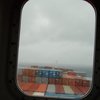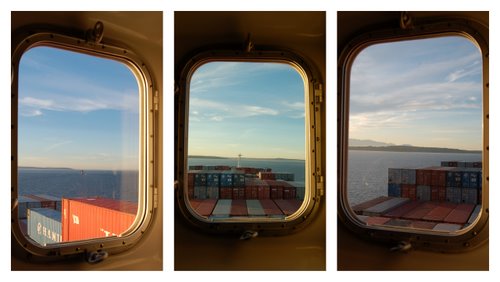
We've arrived in Japan, after ten days traveling by container ship. We boarded the MV Hanjin Madrid at the Port of Seattle, and disembarked today in Yokohama. It was a surprisingly fun trip: the people were nice, the accommodations were comfortable, and the views were beautiful. We have a new appreciation for how incredibly massive the Pacific Ocean is, crossing it mile by mile at ground level.
Click here to see a slideshow
(accommodations, food, engine room, etc.)

SHIP: Container ships carry cargo in containers, the kind you see on freight trains, and are responsible for moving around much of the world's manufactured products. Our ship, the MV Hanjin Madrid, is Korean-owned, and managed by NSB, a German shipping company. It's about twelve stories tall above sea level at peak, and has a capacity of about 4,000 containers. Most of the space on the ship is for cargo. Living quarters are a relatively tiny section in the middle of the ship. We were essentially living in a narrow nine-story apartment building located in a sea of containers. A cargo ship isn't a cruise ship; people, particularly passengers, are incidental. You're cooped up in one tiny area, expected to take care of yourself, and a wide variety of trade-offs are made to optimize for cargo over people. For example, cargo ships don't have stabilizers, so you really feel the ship's every motion.

ACCOMMODATIONS: We felt guilty at how nice the accommodations were. We'd envisioned roughing it across the ocean, but instead, we were put up in a very nice sixth-floor cabin, 320 square feet (30 square meters) in size, with a large sitting room, a bedroom with a queen-sized bed, and small private bathroom. It was essentially a tiny apartment, with furniture, built-in storage, and electronics (CD and DVD players). Crew members spend four months at a time on board, so their rooms are thoughtfully designed to be snug, but comfortable, living spaces. We loved the design details--a discreet built-in retractable clotheslines in the bathroom, a reading light right next to the bed, a desk with handy power outlets, and lots of mirrors to make the space appear larger and brighter. We had access to a shared washer and dryer, a gym room (where we played ping pong), a sauna, and a swimming pool (not filled because of the ship's rocking). We were able to look out the window or step outside anytime to see the ocean. This was the opposite of transoceanic flight, with all its hurry, security theater, and cramped antiseptic spaces.

FOOD: Three meals were served every day, all "hearty sailor fare" -- large, and meat-heavy. We ended up getting small portions, eating a lighter, more vegetarian subset of the full meal. There were separate meals served for officers and crew, though that broke down by lines of nationality, so Europeans (most officers, a few crew members) and passengers would sit in one room and eat "European" food while speaking German and English, and the Filipinos (most crew members, a few officers) would sit in the other room and eat Filipino food while speaking Tagalog. This is the stuff sociology dissertations are made of, but we didn't explore, just ate.
A sample daily menu:
- breakfast: stramer max bread, cereal, cheese, juice, coffee, tea, milk, fruit
- lunch: fried fish, fried potato, French beans, greens with pea soup
- dinner: sweet and sour pork, steamed rice, cucumber salad, cold cuts, cheese, salad

SEASICKNESS: The ship rocked (literally), but we did OK. We'd worried about and prepared for the possibility of nausea but thankfully neither of turned out to be particularly prone to seasickness, barely needing to touch our stash (accupressure wrist bands, ginger gum, Dramamine, and prescription behind-the-ear motion sickness patches). Much of the voyage was quite comfortable, like being in a subway, or a passenger airplane under reasonable conditions; it's easy to ignore low-grade jittery motion. But we did hit ocean turbulence at times, with about a day in the middle when the ship was rocking back and forth heavily, worse than an airplane in heavy turbulence. Of course unlike a plane, we weren't strapped into tiny seats; we'd get up, take a shower, get breakfast, all the normal things people do during a day. Anirvan realized he was blessed with motion drowsiness; whatever it is that makes him drift off on long BART rides kicked in on board, so he kept dozing off as the ship rocked him to sleep, spending 16 hours of a particularly rocky day comfortably asleep.

PEOPLE: It was strange being the only passengers on a working vessel. Everyone else was on a four month stint on board, continuously looping around the Pacific. The officers were mostly German, with a few Poles and Filipinos; the crew was all Filipino, with one European. We got a chance to chat with several people, on and off work time. Folks were incredibly polite, sometimes pretty friendly. It's highly-skilled and relatively well-paid work, but having to spend four of every six months away can be difficult; many sailors have families, keeping in touch with expensive phone calls and limited email. With efficiencies in the industry, shore leave time is now often just hours, giving them little ability to set foot in the countries they deliver goods to. This is a big change. Our captain, for example, had spent two weeks on shore leave in Yokohama back in the less-efficient 1970s. Technology's also made another big difference: almost everyone on board now has personal tech/media stashes: CDs, DVDs, MP3 players full of music, laptops full of movies, games, etc. This means folks spend more free time behind screens and headphones, less social than in the past; some things are the same the world over.

CARGO: Our ship hauled 2,800 cargo containers across the Pacific, carrying goods possily worth between $50 and $500 million (our uneducated estimate). No matter which window we looked out of, which deck we stood on, we were always in a sea of cargo containers in the middle of the ocean. And yet on a day to day basis, the crew seemed to give very little attention to the cargo, besides making sure the containers were safe and secure. The containers are generic and unmarked, and except in the case of dangerous goods, the officers and crew have little or no idea what it is they're hauling. It's a very anonymous experience, acting as the corporate courier service of the seas.

ENVIRONMENT: We decided to travel by cargo container ship because of concerns around the climate impacts of travel, but we learned about a host of other interesting environmental issues and concerns on board:
- fuel: the ship guzzles incredibly massive quantities of low-grade fuel, except near countries that require cleaner higher-grade fuel; the ship carries multiple types of fuel, switching between them as required
- ballast water: when ships pull in seawater at one location, and releases it in another, they risk unintentionally carrying ocean life with them, which can be destructive to recipient ecosystems
- drinking water: we drank and washed with UV-treated desalinated ocean water, probably better-monitored than bottled water on shore.
- sewage disposal: sewage on board is biologically treated and gray water is released into the ocean
- waste disposal: there are a variety of concerns about what and where different kinds of waste can be disposed of; there are also concerns about different ports having different waste disposal practices

TRY THIS AT HOME, KIDS: Taking a container ship instead of a plane worked out really well for us. Container ships are neither sustainable nor scalable, but to the extent that it's greener than flying, we'd totally encourage folks to give freighter travel a try. It's an option for reasonably healthy able-bodied people with flexible schedules and low food restrictions. We got our booking through a company called Freighter World, and would recommend them to others.

You guys are amazing! great job :D
I am absolutely fascinated by this. Last fall, I decided to take the Trans-Sib Railway from Beijing to St. Petersburg. Certainly, it took much longer, but that mode of travel (mainly a traders route, though now becoming more popular as a tourist route to traverse the vastness b/t Europe and Asia) was not only more interesting, but also more responsible. You were able to interact and support local economies of stops along the way. At one point, I considered the boat from Osaka to Shanghai, but that didn't pan out. To compound this fascination, my grandpa, in the 1930s and 1940s, traveled to and from the Philippines via boat -- we suspect a freight like this. Oh, you've planted a seed ...
Jocy--It was really great to see your comment especially since we get on the Trans=Sib tomorrow! Really looking forward to it. It would be amazing if you could trace the path your grandpa took. If you decide to do it, we would love to hear about it.
This is a really cool page you guys have, thanks for sharing your amazing experiences!
Thanks for the great story! I like that you're pursuing greener options for traveling the world and maybe some day I'll try an ocean passage by container ship myself.
Were you guys ever worried about pirates?
Thanks, Nathan. We weren't terribly worried, because we weren't traveling in pirate-heavy routes. That said, the folks on the ship do take security pretty seriously, with procedures in place to respond to attacks through defensive maneuvering and secure lockdowns.
The container shipping industry's job is to get millions of dollars of cargo from point A to point B as safely and quickly as possible -- my sense is that they're generally pretty good at risk mitigation, not because they necessarily all care about their crews, but because hijackings are very bad of business. That made me feel better.
did it cost? if so what was the price comparison to flying?
Yes, cargo ship travel can be double or triple the cost of flying; check with a cargo ship travel booker to get a better sense of the price for the route you have in mind. The journey can also serve as a kind of adventure/vacation on the seas, with the cost of food and hotel built-in.
Dear Anirvan,
I came across your blog by accident. Your story is so wonderful and I would also like to share my freighter travel experience. I have travelled on the Eiffel from Charleston to Egypt with Sea Travel Limited of London. It was an amazing experience. I received a very warm welcome on board and an exceptional service from my booking agent at seatravelltd.co.uk - Tsveti and would also like to recommend them if anybody wants to have a taster to cargo ship cruises.
What about the cost?
This sounds so wonderful and I have a question you may or may not be able to answer. I am trying to travel from Japan to the West Coast by ship but am hoping to work for my passage so I don`t have to pay. Do you know where to look for this kind of opportunity?
Somehow I landed in your webpage. Really liked the blog about freighter travel. I was surprised by the good food choices and the interior decor of the cabins. Great job in describing.
Yes, this is what I was looking for. I want to travel around the worldwithout leaving the world, so trains, buses, boats, donkeys, cars, camela,whatever, but no planes. Everybody told me it is not possible, because of the pacific. Now i know it is!
Thanks!
I'd heard about this, I never imagined there were such nice rooms on board.. I kept picturing dark, damp closets next to the engine room.
I'm more intrigued now, but freighterworld.com seems to be gone...
to whom it may concern,
i really just wanna know of how many days going to travel from Philippine ocean going to japan?
thank you.
Thank you for posting this, and for everyone out there please considering reading Donovan Hohn's Moby Duck, a national best seller. The book's full title is Moby Duck: The True Story of 28,000 Bath Toys Lost at Sea and of the Bechcombers, Oceanographers, Environmentalists, and Fools, Including the Author, Who Went in Search of Them. That, however, is only a hint of what you'll find at the surface of this book.
Rick--I have been meaning to read Moby Duck for while now--Thanks for the reminder and recommendation!